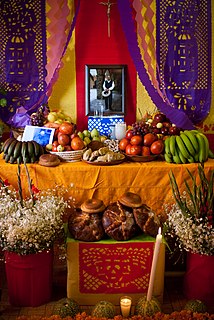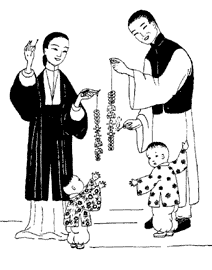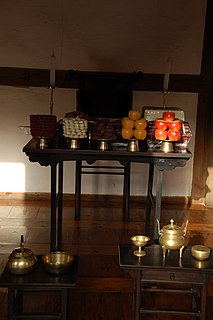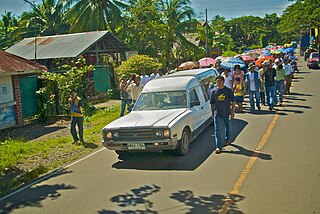
All Souls' Day, also known as the Commemoration of All the Faithful Departed and the Day of the Dead, is a day of prayer and remembrance for the faithful departed, which is observed by Roman Catholics and other Christian denominations annually on 2 November. All Souls' Day is often celebrated in Western Christianity; Saturday of Souls is a related tradition more frequently observed in Eastern Christianity. Adherents of All Souls' Day traditions often remember deceased friends and relatives in various ways on the day. Through prayer, intercessions, alms and visits to cemeteries, people commemorate the poor souls in purgatory and gain them indulgences. Beliefs and practices associated with All Souls' Day vary widely among Christian denominations.

Easter eggs, also called Paschal eggs, and Egg of Easter are eggs that are sometimes decorated. They are usually used as gifts on the occasion of Easter. As such, Easter eggs are common during the season of Eastertide. The oldest tradition is to use dyed and painted chicken eggs, but a modern custom is to substitute chocolate eggs wrapped in coloured foil, hand-carved wooden eggs, or plastic eggs filled with confectionery such as chocolate. However, real eggs continue to be used in Central and Eastern European tradition.

Easter, also called Pascha, Zatik (Armenian) or Resurrection Sunday is a Christian festival and cultural holiday commemorating the resurrection of Jesus from the dead, described in the New Testament as having occurred on the third day of his burial following his crucifixion by the Romans at Calvary c. 30 AD. It is the culmination of the Passion of Jesus, preceded by Lent, a 40-day period of fasting, prayer, and penance.

A funeral is a ceremony connected with the final disposition of a corpse, such as a burial or cremation, with the attendant observances. Funerary customs comprise the complex of beliefs and practices used by a culture to remember and respect the dead, from interment, to various monuments, prayers, and rituals undertaken in their honor. Customs vary between cultures and religious groups. Funerals have both normative and legal components. Common secular motivations for funerals include mourning the deceased, celebrating their life, and offering support and sympathy to the bereaved; additionally, funerals may have religious aspects that are intended to help the soul of the deceased reach the afterlife, resurrection or reincarnation.

Palm Sunday is a Christian moveable feast that falls on the Sunday before Easter. The feast commemorates Jesus' triumphal entry into Jerusalem, an event mentioned in each of the four canonical Gospels. Palm Sunday marks the first day of Holy Week. For adherents of Nicene Christianity, it is the last week of the Christian solemn season of Lent that precedes the arrival of Eastertide.

The veneration of the dead, including one's ancestors, is based on love and respect for the deceased. In some cultures, it is related to beliefs that the dead have a continued existence, and may possess the ability to influence the fortune of the living. Some groups venerate their direct, familial ancestors. Certain sects and religions, in particular the Eastern Orthodox Church and Roman Catholic Church, venerate saints as intercessors with God; the latter also believes in prayer for departed souls in Purgatory. Other religious groups, however, consider veneration of the dead to be idolatry and a sin.

The Day of the Dead is a holiday traditionally celebrated on November 1 and 2, though other days, such as October 31 or November 6, may be included depending on the locality. It largely originated in Mexico, where it is mostly observed, but also in other places, especially by people of Mexican heritage elsewhere. Although associated with the Western Christian Allhallowtide observances of All Hallow's Eve, All Saints' Day and All Souls' Day, it has a much less solemn tone and is portrayed as a holiday of joyful celebration rather than mourning. The multi-day holiday involves family and friends gathering to pay respects and to remember friends and family members who have died. These celebrations can take a humorous tone, as celebrants remember funny events and anecdotes about the departed.

Memorial Day is a federal holiday in the United States for mourning the U.S. military personnel who have died while serving in the United States armed forces. It is observed on the last Monday of May. It was formerly observed on May 30 from 1868 to 1970.

A wreath is an assortment of flowers, leaves, fruits, twigs, or various materials that is constructed to form a ring.

Allhallowtide, Hallowtide, Allsaintstide, or the Hallowmas season, is the Western Christian season encompassing the triduum of All Saints' Eve (Halloween), All Saints' Day and All Souls' Day, as well as the International Day of Prayer for the Persecuted Church and Remembrance Sunday in some traditions. The period begins on 31 October annually. Allhallowtide is a "time to remember the dead, including martyrs, saints, and all faithful departed Christians." The present date of Hallowmas and thus also of its vigil (Hallowe'en) was established for Rome perhaps by Pope Gregory III (731–741) and was made of obligation throughout the Frankish Empire by Louis the Pious in 835. Elsewhere, other dates were observed even later, with the date in Ireland being 20 April. In the early 11th century, the modern date of All Souls' Day was popularized, after Abbot Odilo established it as a day for the monks of Cluny and associated monasteries to pray for the dead.

The Qingming festival or Ching Ming Festival, also known as Tomb-Sweeping Day in English, is a traditional Chinese festival observed by the Han Chinese of mainland China, Taiwan, Hong Kong, Macau, Malaysia, Singapore, Indonesia, Thailand and by the ethnic Chinese of Malaysia and Singapore. It falls on the first day of the fifth solar term of the traditional Chinese lunisolar calendar. This makes it the 15th day after the Spring Equinox, either 4, 5 or 6 April in a given year. During Qingming, Chinese families visit the tombs of their ancestors to clean the gravesites, pray to their ancestors and make ritual offerings. Offerings would typically include traditional food dishes and the burning of joss sticks and joss paper. The holiday recognizes the traditional reverence of one's ancestors in Chinese culture.

Dziady is a term in Slavic folklore for the spirits of the ancestors and a collection of pre-Christian rites, rituals and customs that were dedicated to them. The essence of these rituals was the "communion of the living with the dead", namely, the establishment of relationships with the souls of the ancestors, periodically returning to their headquarters from the times of their lives. The aim of the ritual activities was to win the favor of the deceased, who were considered to be caretakers in the sphere of fertility. The name "dziady" was used in particular dialects mainly in Poland, Belarus, Polesia, Russia and Ukraine, but under different other names there were very similar ritual practices, common among Slavs and Balts, and also in many European and even non-European cultures.

Radonitsa, also spelled Radunitsa, Radonica, or Radunica, in the Russian Orthodox Church is a commemoration of the departed observed on the second Tuesday of Pascha (Easter) or, in some places, on the second Monday of Pascha. In Ukrainian tradition it is called Provody (Проводи).

All Saints' Day, also known as All Hallows' Day, the Feast of All Saints, the Feast of All Hallows, the Solemnity of All Saints, and Hallowmas, is a Christian solemnity celebrated in honour of all the saints of the church, whether they are known or unknown.

A Jewish cemetery is a cemetery where Jews are buried in keeping with Jewish tradition. Cemeteries are referred to in several different ways in Hebrew, including beit kevarot, beit almin or beit olam [haba],, the beit chayyim and beit shalom.

A death anniversary is the anniversary of the death of a person. It is the opposite of birthday. It is a custom in several Asian cultures, including Azerbaijan, Armenia, Cambodia, China, Georgia, Hong Kong, Taiwan, India, Myanmar, Iran, Israel, Japan, Bangladesh, Korea, Nepal, Pakistan, the Philippines, Russia, Sri Lanka and Vietnam, as well as in other places with significant overseas Chinese, Japanese, Jewish, Korean, and Vietnamese populations, to observe the anniversary on which a family member or other significant individual died. There are also similar memorial services that are held at different intervals, such as every week.

During the Pre-Hispanic period the early Filipinos believed in a concept of life after death. This belief, which stemmed from indigenous ancestral veneration and was strengthened by strong family and community relations within tribes, prompted the Filipinos to create burial customs to honor the dead through prayers and rituals. Due to different cultures from various regions of the Philippines, many different burial practices have emerged. For example, the Manobos buried their dead in trees, the Ifugaos seated the corpse on a chari before it was brought to a cave and buried elsewhere. The most common forms of traditional burials are supine pits, earthenware jars, and log coffins, and have been a topic of interest among Philippine archaeologists since the early 20th century.
Decoration Day refers to traditions of cemetery decoration and ritual, including:
Cemetery Sunday is an annual ancestor veneration observance held in Roman Catholic and other cemeteries in some areas of Ireland and along routes of Irish migration. Parishioners prepare by cleaning family graves and, in some cemeteries, decorating the graves. Grave decorations incorporate flowers as well as crafts and mementos. In cemeteries where a priest is not available, Cemetery Sunday may still be held absent the formal service and blessing.

In southern Wales and nearby portions of England, Sul y Blodau or Flowering Sunday is a grave decoration tradition commonly observed on Palm Sunday, although historically Flowering Sunday grave decoration was also observed on other days as well. It is traditional to whitewash and decorate graves with flowers on Flowering Sunday. Today, the names Palm Sunday and Flowering Sunday are used interchangeably in Wales. Scholars Alan and Karen Jabbour have postulated that Flowering Sunday might be connected to Appalachian and Liberian Decoration Day cemetery traditions. Flowering Sunday is also known as Blossom Sunday in some portions of England.























